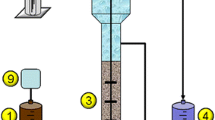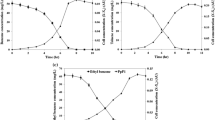Abstract
This study explores the effect of microbial consortium composition and reactor configuration on methyl tert-butyl ether (MTBE) biodegradation in the presence of benzene, toluene, ethylbenzene and p-xylenes(BTEX). MTBE biodegradation was monitored in the presence and absence of BTEX in duplicate batch reactors inoculated with distinct enrichment cultures: MTBE only (MO—originally enriched on MTBE) and/or MTBE BTEX (MB—originally enriched on MTBE and BTEX). The MO culture was also applied in a semi-batch reactor which received both MTBE and BTEX periodically in fresh medium after allowing cells to settle. The composition of the microbial consortia was explored using a combination of 16S rRNA gene cloning and quantitative polymerase chain reaction targeting the known MTBE-degrading strain PM1T. MTBE biodegradation was completely inhibited by BTEX in the batch reactors inoculated with the MB culture, and severely retarded in those inoculated with the MO culture (0.18 ± 0.04 mg/L-day). In the semi-batch reactor, however, the MTBE biodegradation rate in the presence of BTEX was almost three times as high as in the batch reactors (0.48 ± 0.2 mg/L-day), but still slower than MTBE biodegradation in the absence of BTEX in the MO-inoculated batch reactors (1.47 ± 0.47 mg/L-day). A long lag phase in MTBE biodegradation was observed in batch reactors inoculated with the MB culture (20 days), but the ultimate rate was comparable to the MO culture (0.95 ± 0.44 mg/L-day). Analysis of the cultures revealed that strain PM1T concentrations were lower in cultures that successfully biodegraded MTBE in the presence of BTEX. Also, other MTBE degraders, such as Leptothrix sp. and Hydrogenophaga sp. were found in these cultures. These results demonstrate that MTBE bioremediation in the presence of BTEX is feasible, and that culture composition and reactor configuration are key factors.




Similar content being viewed by others
References
Bond PL, Hugenholtz P, Keller J, Blackall LL (1995) Bacterial community structures of phosphate-removing and non-phosphate-removing activated sludges from sequencing batch reactors. Appl Environ Microbiol 61(5):1910–1916
Bruns MA, Hanson JR, Mefford J, Aswath M, Scow KM (2001) Isolate PM1 populations are dominant and novel methyl tert-butyl ether-degrading bacterial in compost biofilter enrichments. Environ Microbiol 3(3):220–225
Ciesielski S, Cydzik-Kwiatkowska A, Pokoj T, Klimiuk E (2006) Molecular detection and diversity of medium-chain-length polyhydroxyalkanoates-producing bacteria enriched from activated sludge. J Appl Microbiol 101 (1):190–199
Curtis TP, Sloan WT (2006) Towards the design of diversity: stochastic models for community assembly in wastewater treatment plants. Water Sci Technol 54(1):227–236
Dabert P, Sialve B, Delgenes JP, Moletta R, Godon JJ (2001) Characterisation of the microbial 16S rDNA diversity of an aerobic phosphorus-removal ecosystem and monitoring of its transition to nitrate respiration. Appl Microbiol Biotechnol 55(4):500–509
Deeb RA, Hu H-Y, Hanson JR, Scow KM, Alvarez-Cohen L (2001) Substrate interaction in BTEX and MTBE mixtures by an MTBE-degrading isolate. Environ Sci Technol 35(2):312–317
Deeb RA, Chu KH, Shih T, Linder S, Suffet I, Kavanaugh MC, Alvarez-Cohen L (2003) MTBE and other oxygenates: environmental sources, analysis, occurrence and treatment. Environ Eng Sci 20(5):433–444
Eiler A, Bertilsson S (2004) Composition of freshwater bacterial communities associated with cyanobacterial blooms in four Swedish lakes. Environ Microbiol 6(12):1228–1243
Fayolle F, Francois A, Garnier L, Godefroy D, Mathis H, Piveteau P, Monot F (2003) Limitation in MTBE biodegradation. Oil Gas Sci Technol 58(4):497–504
Fennell DE, Carroll AB, Gossett JM, Zinder SH (2001) Assessment of indigenous reductive dechlorinating potential at a TCE-contaminated site using microcosms, polymerase chain reaction analysis, and site data. Environ Sci Technol 35(9):1830–1839
Feris KP, Hristova K, Gebreyesus B, Mackay D, Scow KM (2004) A shallow BTEX and MTBE contaminated aquifer supports a diverse microbial community. Microbial Ecol 48(4):589–600
Finneran KT, Lovley DR (2001) Anaerobic degradation of methyl tert-butyl ether (MTBE) and tert-butyl alcohol (TBA). Environ Sci Technol 35(9):1785–1790
Fortin NY, Morales M, Nakagawa Y, Focht DD, Deshusses MA (2001) Methyl tert-butyl ether (MTBE) degradation by a microbial consortium. Environ Microbiol 3(6):407–416
Francois A, Mathis H, Godefroy D, Piveteau P, Fayolle F (2002) Biodegradation of methyl tert-butyl ether and other fuel oxygenates by a new strain, Mycobacterium austroafricanum IFP 2021. Appl Environ Microbiol 68(6):2754–2762
Hanson JR, Ackerman CE, Scow KM (1999) Biodegradation of methyl tert-butyl ether by a bacterial pure culture. Appl Environ Microbiol 65(11):4788–4792
Hatzinger PB, McClay K, Vainberg S, Tugusheva M, Condee CW, Steffan RJ (2001) Biodegradation of methyl tert-butyl ether by a pure bacterial culture. Appl Environ Microbiol 67:5601–5607
Hristova K, Lutenegger CM, Scwo KM (2001) Detection and quantification of methyl tert-butyl ether-degrading strain PM1 by real-time TaqMan PCR. Appl Environ Microbiol 67(11):5154–5160
Hristova K, Gebreyesus B, Mackay D, Scow KM (2003) Naturally occurring bacteria similar to the methyl tert-butyl ether(MTBE)-degrading strain PM1 are present in MTBE-contaminated groundwater. Appl Environ Microbiol 69(5):2616–2623
Krooneman J, Wieringa EB, Moore ER, Gerritse J, Prins RA, Gottschal JC (1996) Isolation of Alcaligenes sp. strain L6 at low oxygen concentrations and degradation of 3-chlorobenzoate via a pathway not involving (chloro)catechols. Appl Environ Microbiol 62(7):2427–2434
Lee SK, Sun Bok L (2002) Substrate utilization patterns during BTEX biodegradation by an o-xylene-degrading bacterium Ralstonia sp. PHS1 J Microbiol Biotechnol 12(6):909–915
Lee JW, Im WT, Kim MK, Yang DC (2006) Lysobacter koreensis sp nov., isolated from a ginseng field. Intl J Syst Evol Microbiol 56(1):231–235
Mo K, Lora CO, Wanken AE, Javanmardian M, Yang X, Kulpa CF (1997) Biodegradation of methyl t-butyl ether by pure bacterial cultures. Appl Microbiol Biotechnol 47:69–72
Pruden A, Suidan M (2004) Effect of benzene, toluene, ethylbenzene, and p-xylene (BTEX) mixture on biodegradation of methyl tert-butyl ether (MTBE) and tert-butyl alcohol (TBA) by pure culture UC1. Biodegradation 15(4):213–227
Pruden A, Suidan MT, Venosa AD, Wilson GJ (2001) Biodegradation of methyl tert-butyl ether under various substrate conditions. Environ Sci Technol 21:4235–4241
Ralebitso TK, Roling WFM, Braster M, Senior E, van Verseveld HW (2001) 16S rDNA-based characterization of BTX-catabolizing microbial associations isolated from a South African sandy soil. Biodegradation 11(6):351–357
Salanitro JP, Diaz LA, Williams MP, Wisniewski HL (1994) Isolation of a bacterial culture that degrades methyl t-butyl ether. Appl Environ Microbiol 60:2596–2596
Sameshima R, Isawa T, Sadowsky MJ, Hamada T, Kasai H, Shutsrirung A, Mitsui H, Minamisawa K (2003) Phylogeny and distribution of extra-slow-growing Bradyrhizobium japonicum harboring high copy numbers of RS alpha, RS beta and IS1631. FEMS Microbiol Ecol 44 (2):191–202
Sanchez O, Diestra E, Esteve I, Mas J (2005) Molecular characterization of an oil-degrading cyanobacterial consortium. Microbial Ecol 50(4):580–588
Sedran MA, Pruden A, Wilson GJ, Suidan MT, Venosa AD (2002) Effect of BTEX on degradation of MTBE and TBA by mixed bacterial consortium. J Environ Eng (September) 128(9):830–835
Squillace PJ, Moran MJ, Lapham WW, Price CV, Clawges RM, Zogorski JS (1999) Volatile organic compounds in untreated ambient groundwater of the United States, 1985–1995. Environ Sci Technol 33:4176–4187
Steffan RJ, McClay K, Vainberg S, Condee CW, Zhang D (1997) Biodegradation of gasoline oxygenates methyl tert-butyl ether, ethyl tert-butyl ether and tert-amyl methyl ether by propane-oxidizing bacteria. Appl Environ Microbiol 63(11):4216–4222
Stocking AJ, Deeb RA, Flores AE, Stringfellow W, Talley J, Brownell R, Kavanaugh MC (2000) Bioremediation of MTBE: a review from a practical perspective. Biodegradation 11:187–201
Straub PF, Reynolds PH, Althomsons S, Mett V, Zhu Y, Shearer G, Kohl DH (1996) Isolation, DNA sequence analysis, and mutagenesis of a proline dehydrogenase gene (putA) from Bradyrhizobium japonicum. Appl Environ Microbiol 62(1):221–229
Suzuki MT, Taylor LT, DeLong EF (2000) Quantitative analysis of small subunit ribosomal RNA genes in mixed microbial populations using 5′-nuclease assays. Appl Environ Microbiol 66:4605–4614
Thomas JC, Berger F, Jacquier M, Bernillon D, Baud-Grasset F, Truffaut N, Normand P, Vogel TM, Simonet P (1996) Isolation and characterization of a novel gamma-hexachlorocyclohexane-degrading bacterium. J Bacteriol 178(20):6049–6055
USEPA (2005) List of drinking water contaminants and MCLs. From http://www.epa.gov/safewater/mcl.html#mcls
USEPA (2006) Methyl tertiary butyl ether (MTBE). From http://www.epa.gov/mtbe/. Retrieved 26 Jun 2006
Weisburg WG, Barns SM, Pelletier DA, Lane DJ (1991) 16S ribosomal DNA amplification for phylogentic study. J Bacteriol 173:697–703
Acknowledgments
The authors thank SunCor Oil for their financial support of this research and Makram Suidan at the University of Cincinnati for provision of the cultures used in this study.
Author information
Authors and Affiliations
Corresponding author
Rights and permissions
About this article
Cite this article
Raynal, M., Pruden, A. Aerobic MTBE biodegradation in the presence of BTEX by two consortia under batch and semi-batch conditions. Biodegradation 19, 269–282 (2008). https://doi.org/10.1007/s10532-007-9133-7
Received:
Accepted:
Published:
Issue Date:
DOI: https://doi.org/10.1007/s10532-007-9133-7




